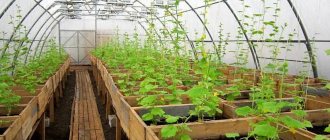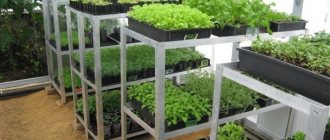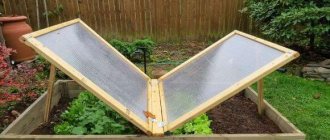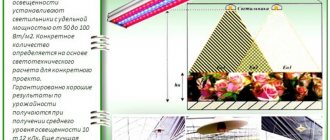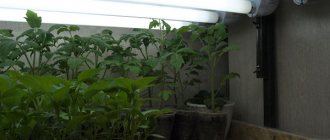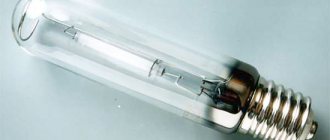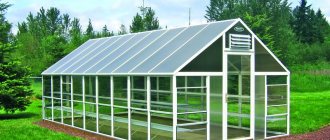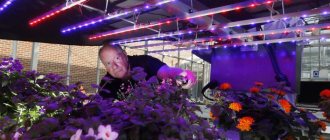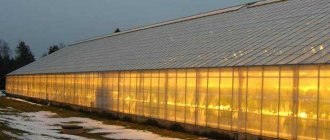To ensure the most favorable “climate” in the greenhouse, lighting plays an important role. Through numerous experiments and serious scientific research, induction lamps for plants have been developed that very accurately simulate sunlight. Lamps of this type provide plants with the “light supply” of the necessary spectrum and saturation. With their help, diurnal and seasonal cycles are accurately simulated in the greenhouse, which helps increase yields and reduces greenhouse maintenance costs.
This article will discuss the types of induction lamps for greenhouses, their advantages and disadvantages, selection rules and options for their use.
What is an induction lamp
An induction lamp is, by its design, a modernized fluorescent lamp. The main difference is the absence of electrodes and the presence of an induction coil.
Induction lamp design
The design of an induction fluorescent lamp includes the following elements:
- a gas-discharge tube, the inner surface of which is coated with a phosphor;
- an induction coil with a magnetic ring, which is mounted around the gas-discharge tube;
- a high-frequency current generator (electronic ballast), which can be built into the lamp body or installed separately.
Ammeter internal resistance
It should be less than the resistance of the circuit itself. The indicator is calculated after measurements with a voltmeter, which is connected in parallel with the ammeter. Then the readings of the second are divided by the readings of the first, the result is internal resistance. A small value is necessary so that the voltage drop across the device does not affect the accuracy of measurements.
This device is one of the simplest and most common. How to use ammeters is taught in physics lessons, so there should not be any special problems during operation, especially with the advent of digital ammeters, which have significantly simplified the nuances of working with the device and expanded the scope of its application.
Types of induction lamps for greenhouses
Modern industry produces induction lamps for greenhouses of the following types:
- TILgp is a universal lamp for greenhouses. Its balanced spectrum of lighting is suitable for any plants during the period of their growth and fruit ripening. The ratio of the red and blue spectrum in such lamps is 40% and 49%. The total yield of light useful for plants is 95.8%.
- TILgp (fl)+kl – modification of a universal lamp. Additional control allows you to make appropriate changes to the total spectrum, creating the effect of sunrise and sunset.
- TILvg – ratio of red and blue spectrum 31/59. Vegetative cultivation and germination of plants will proceed better under the light of such a lamp. The total yield of light useful for plants is 96.5%.
- TILfl - this type of lighting is ideal for plants during the period of fruit ripening. Red spectrum 50%. The total yield of light useful for plants is 96.5%.
What is it used for?
Growing plants under a UV element.
Modern UV emitters are used in the following areas:
- Water purification. Effective disinfection of water from bacteria and germs before use. Both household disinfection of the home and the organization of treatment stations are possible.
- Lighting in clubs. Safe UV lamps are used to organize unusual lighting effects during parties or discos.
- A tan. As an artificial substitute for the sun, UV radiation can provide a person with an even and beautiful tan. You can achieve this at home using a compact emitter, but for a high-quality tan it is better to go to a solarium.
- Medicine. With the help of UV sources you can treat runny nose, colds and throat diseases. For this purpose, devices with special attachments are used.
- Checking documents and banknotes. All valuable forms and money have a set of components invisible to the eye, degrees of authenticity protection. Under UV light these hidden signs can be seen.
- Growing plants. The emitters are capable of providing plants with the ultraviolet radiation necessary for development. This speeds up growth and makes the growing process stable.
- Applying manicure. Using UV manicure lamps, various gel polishes and shellacs are fixed in salons or at home.
Lamp for manicure Sunuv Sun9X Plus 18LED UV 36W.
This is not a complete list of areas of application of UV emitters.
Advantages and disadvantages
The main advantage of this type of light sources is that the luminous flux they emit, in its main characteristics, is as close as possible to sunlight.
Dependence of plant activity on light wavelength
In addition, the use of induction lamps for lighting greenhouses has a number of other advantages, among which the following deserve special attention;
- High color rendering index Ra > 80.
- Low operating temperature. The bulbs of these lamps are heated to a temperature of 50-70 °C, which allows, by significantly reducing the distance between the lamp and the plants, to increase the light intensity without causing harm to the plants. In addition, the use of such lighting improves humidity control and, as a result, reduces the need for watering plants.
- Long service life. The service life of induction-type light sources reaches 100,000 hours. TIL can function effectively for 15-20 years. TIL manufacturers, as a rule, provide at least a five-year warranty on their products.
- Immunity to temperature changes. TIL functions equally effectively in the range from -35 to +40-50 °C.
Economical. The use of TIL allows you to save energy. For example, replacing a sodium gas-discharge lamp DNAT 600W with a TIL 300W provides 56% direct savings in energy costs. Compared to LED lamps, TIL allows you to save about 40% of costs.
- Easy to install and operate. In order to remove or install the device with your own hands, no special skills or knowledge are required.
- Safety. The light source is contained in a sealed glass tube. Leak excluded. The low operating temperature poses no danger to either people or plants.
When naming the disadvantages of induction lamps, we can mention their high cost. But, considering the purchase of such a lamp as a “long-term investment”, it should be recognized that the money spent on the purchase of these devices quickly pays off.
Best before date
The service life of a product depends on its quality.
LN should be stored in a cardboard box. This is necessary so as not to accidentally break it or so that it does not give an imperceptible crack that will ruin the whole work. Because of such a crack, the gas will evaporate; as a result, after the light bulb is screwed into the lampshade, it will work for no more than 2-3 hours. You must follow safety rules when screwing the lamp into the lampshade. Children should not be allowed to participate in this process, and it is also advisable to completely turn off the electricity supply in the room. Note! Used light bulbs must be disposed of properly and should not be thrown away with food waste. Every city has special bins for such waste.
If you follow all the rules of storage and use, the lamp will last as long as possible, without defects.
Vintage Edison lamp
How to choose the right lamp
Having determined all the advantages and disadvantages of induction lighting, you can begin to select lamps for your greenhouse.
First, you need to clearly define the tasks that are set for the greenhouse and the goals that you want to achieve as a result of its operation.
Universal lamps (TILgp, TILgp (fl)+kl) - a wide spectrum of radiation and the possibility of dimming (changing the radiation intensity) allow the use of these lamps throughout the entire life cycle of plants.
To grow seedlings, the use of universal light sources is inappropriate, first of all, from an economic point of view. Universal lamps are not cheap.
There are highly specialized induction lamps designed for specific stages of plant development. Their cost is several times less than universal ones. Using such lamps will bring you significant cost savings.
For the germination stage, it is advisable to use light sources of the TILvg type, the other spectrum of which is 59%. TILfl induction lamps, in which the amount of red spectrum is 50%, are “appropriate” at the stage of flowering and fruit formation (set).
The lamp is effective for illuminating seedlings before planting in the ground
Characteristics
One of the main parameters of incandescent light bulbs will be the power, indicated in watts. The purpose of the lamps is different, so the range of choice is large - from 0.1 W “lamp” to 23 thousand W floodlights for airfields.
In everyday life, low-power light bulbs are used, usually from 15 W to 200 W, and in production they use lamps with a power of up to 2000 W.
The quality of the light beam and the level of dispersion are regulated by the material of the vessel.
car light bulb
The greatest light transmission is inherent in products with transparent glass, because they do not absorb light. The matte surface of the lamp absorbs 5% of light rays, and the white surface absorbs 15%.
The size of incandescent light bulbs can be from 60 mm to 130 mm. Depends on the scope of application.
Installation and distribution in the greenhouse
When installing induction lighting in a greenhouse with your own hands, you must take into account that, unlike other types of lamps, even such well-known and familiar ones as fluorescent ones, an induction lamp does not create a powerful heat flux, the electric ballast and the gas-discharge tube do not emit a lot of heat. This important feature of induction light sources allows you to reduce the distance to a minimum and install them in close proximity to plants or the soil surface.
The use of induction lamps of different types allows you to design and install separate lighting for each section of the greenhouse. For example, when installing row lighting, you don’t have to worry about damage to the lighting intensity or overlap of light fluxes from other lamps. The design features of TILs and their unique technical characteristics make their operation very convenient. Together with such lamps, various devices can be used, which will make the greenhouse lighting system more flexible.
To direct the maximum amount of light to the desired sector, you can use special screens that have different shapes and allow you to focus the light flux on the desired area.
As a rule, such screens are equipped with “wings”, planes with easily variable rotation angles. Such designs allow you to adjust the direction of the light flux, thereby creating sectors with different illumination. For example, using a parabolic reflector you can evenly distribute light over the entire height of the plant.
What kind of light do plants need to develop?
Artificial lighting of beds
When choosing a greenhouse lamp, gardeners pay the main attention to the light spectrum and illumination in lux (lx). The second indicator is selected depending on the plants grown in the greenhouse:
- 1000–3000 lux – for shade-loving beets or cabbage;
- 3000–4000 lux – for shade-tolerant cucumbers and zucchini;
- 4000–6000 lux – for light-loving nightshades and tropical fruits.
Each light range affects plants differently. Moreover, the influence practically does not depend on the type of vegetation; for all it is largely the same:
- 280–320 nm – only harms crops;
- 320–400 nm – has minimal impact;
- 400–500 nm – “blue” light is involved in photosynthesis;
- 500–600 nm – “green” is needed for photosynthesis of the lower leaves;
- 600–750 nm – “red” affects the development and regulation of cultivated crops.
The activity of growth processes depends on the light spectrum
UV (less than 380 nm) and IR (more than 780 nm) radiation are not required for photosynthesis. They have a greater effect on the color and rate of aging of leaves.
Plants grown in greenhouses and greenhouses require “blue” and “red” light. They are emitted by a bispectral induction lamp, which was specially developed for use in greenhouses.
conclusions
One of the main disadvantages of IL is its high price. Such lamps cost from 1000 rubles. Manufacturers provide a long warranty period - as much as 5 years. Calculations show that the cost of purchasing one IL pays off within 1-1.5 years, depending on the power and duration of operation.
Induction lighting significantly reduces electricity consumption. Consequently, the load on the wiring will be minimal. This is especially true for lighting large areas: urban, industrial, etc.
In general, it can be noted that the most promising area of application of IL is precisely the lighting of large spaces. The use of IL in everyday life is limited by its size and harmful radiation: electromagnetic and ultraviolet. And for industrial enterprises and the national economy, induction lamps are a good way to illuminate large areas with high quality and relatively inexpensively.
Recommendations for use ↑
Induction lamps can be placed on cables in such a way that their position in height can be adjusted.
If necessary, bring the device closer to the plants at a distance of up to 20 cm; its slight heating will prevent damage to the leaves and dry out the air.
For long, trouble-free service, simple technical conditions for installation and proper operation must be observed. It is easy to install an induction lamp under the greenhouse dome yourself according to the instructions, without the help of specialists.
The use of special devices - reflectors (screens with surfaces of different shapes) allows you to direct the light flux to the desired place in the greenhouse.
The popularity of induction lamps in greenhouse farming is due to the range that is most suitable for the spectrum and high radiation power, the use of energy-saving technologies and relatively quick payback.
